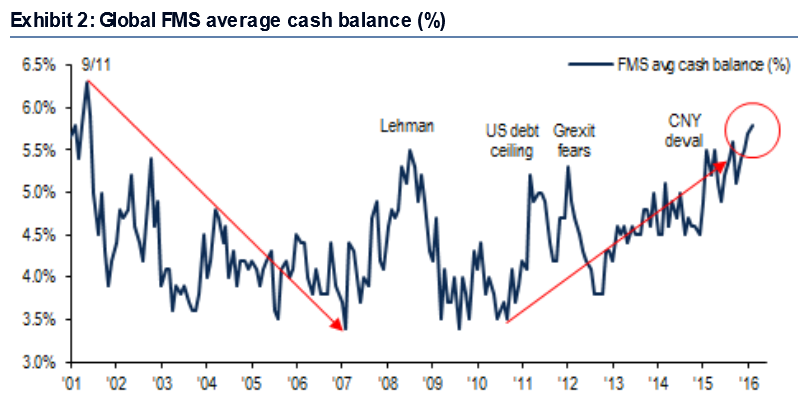Investors are stockpiling cash and exiting European and UK assets, according to a survey of asset managers.
The average cash balance among 160 global investors rose to 5.8% this month, according to Bank of America Merrill Lynch’s (BoAML) research. This was the highest level recorded by the survey since November 2001.
Managers are also buying protection against stock market falls at a record rate, BoAML reported, while taking up underweight positions in equities, especially in the Eurozone and the UK following the latter’s vote to leave the European Union (EU).
The survey reported participants’ first net underweight to the Eurozone in three years after a collapse in sentiment. In June, allocators had a net overweight to the region of 26%; by July this had fallen to a net 4% underweight.
Asked about future central bank policy, 39% of respondents said they expected at least one major central bank to adopt a “helicopter money” strategy in the next 12 months, injecting cash directly into the economy rather than buying government bonds.
A net 44% of investors said global fiscal policy was “currently too restrictive”—a record level for BoAML’s survey.
 Managers’ average cash balance. Source: BoAML Global Fund Manager Survey.Reflecting the
shift in sentiment, Columbia Threadneedle’s European CIO Mark Burgess this week
stated his firm had pulled back on its favorable view of equities, which it had
held for more than five years.
Managers’ average cash balance. Source: BoAML Global Fund Manager Survey.Reflecting the
shift in sentiment, Columbia Threadneedle’s European CIO Mark Burgess this week
stated his firm had pulled back on its favorable view of equities, which it had
held for more than five years.
The post-referendum equity rally “feels somewhat unjustified and unsupported by the fundamentals,” Burgess said. “There are going to be a number of headwinds facing the UK economy as it detaches itself from the EU over the coming years, which will likely reduce economic activity in the UK and impact domestic profits.”
The impact of the US elections in November and a possible broader fallout from Brexit across the EU were also important concerns, Burgess added. “We are also mindful of the global debt burden and global overcapacity, and are particularly alert to the alarmingly high levels of non-performing loans in the Italian banking system, as well as China’s ongoing attempts to rebalance its economy.”
Related:Managers Brace for ‘Summer of Shocks’ & Waking Up to a Different Europe

